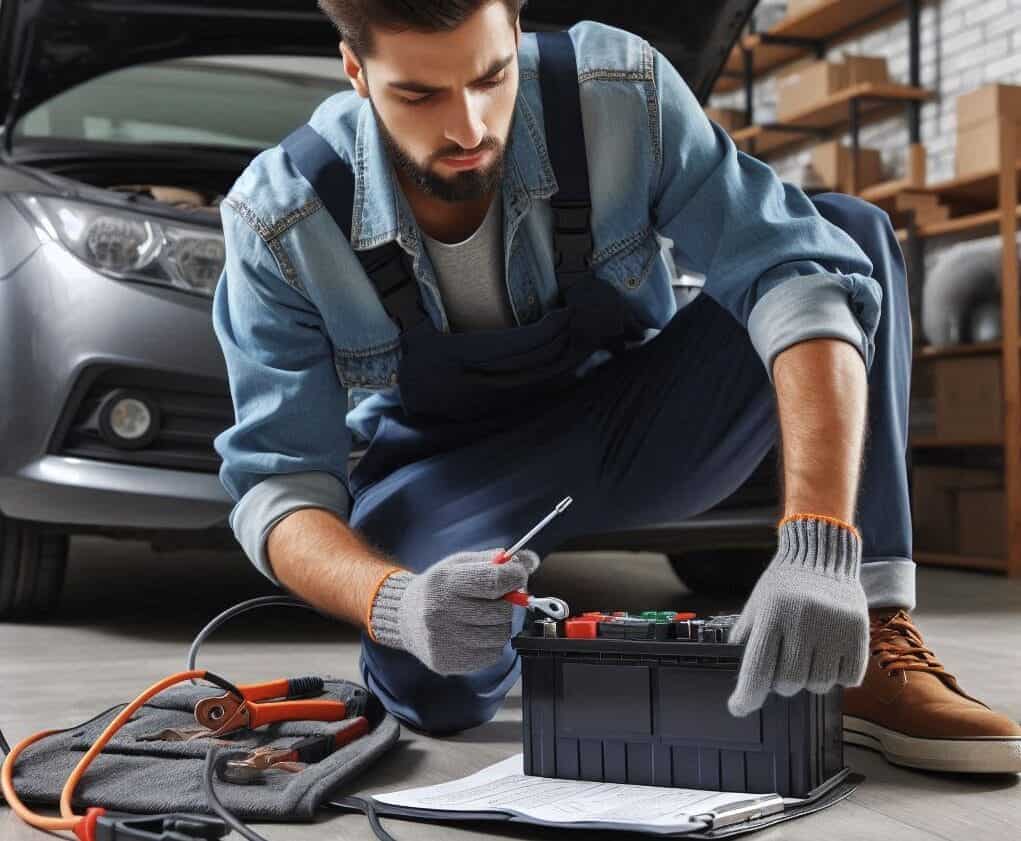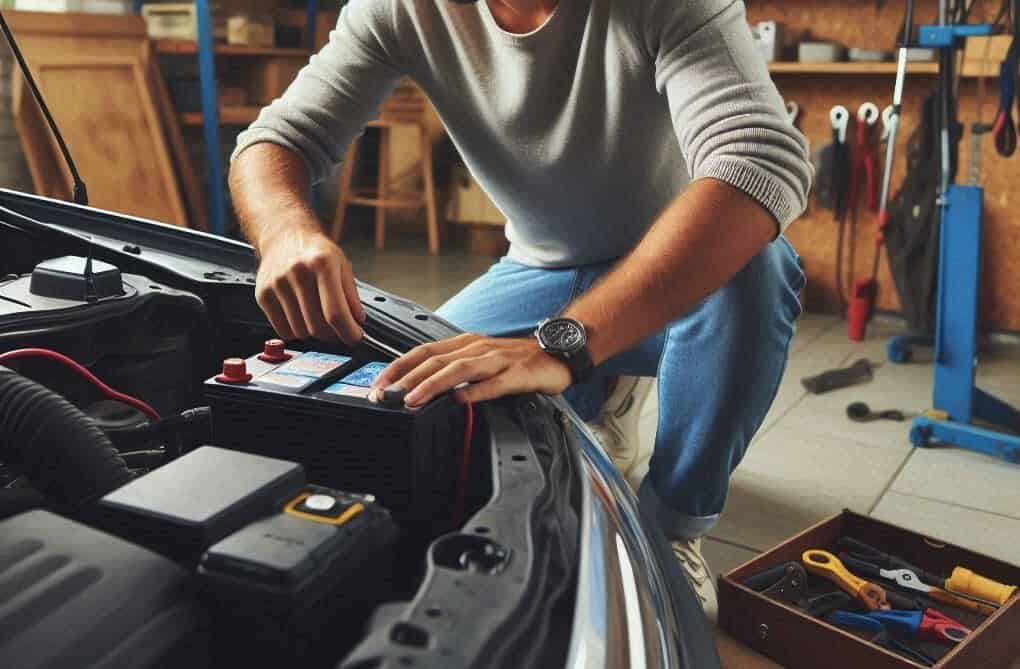A car battery is the heart of your vehicle’s electrical system. It powers everything from the ignition to the lights, and without it, your car simply won’t run. Whether you’re starting your engine, running your radio, or charging your phone, a reliable car battery is essential for smooth vehicle performance.
- Why Car Battery Replacement Matters
- Signs That Your Car Battery Needs Replacement
- Preparing for the Replacement
- Step-by-Step Guide to Replace Your Car Battery
- Essential Tips for Maintaining a Healthy Car Battery
- Proper Disposal and Recycling of Old Batteries
- Summing Up
- FAQs (Frequently Asked Questions)
Key Takeaway
In this guide, I will walk you through the step-by-step process of replacing a car battery and share essential maintenance tips to prolong its lifespan.
Why Car Battery Replacement Matters
Car batteries have a limited lifespan, usually between 3-4 years, even with proper care. Recognizing when your car battery needs replacement can save you from unexpected breakdowns and costly repairs. Common signs that you may need a new battery include:
- Dimming headlights
- Slow cranking of the engine
- Frequent need for jump-starts
- Illuminated warning lights on the dashboard
What You Will Learn
By following this guide, you’ll gain practical knowledge on:
- Identifying Signs of a Failing Battery: Learn how to recognize early warning signals that indicate your battery may be on its last legs.
- Preparing for Replacement: Understand the importance of safety gear and gather all necessary tools before diving into the replacement process.
- Step-by-Step Replacement Process: Detailed instructions to ensure you replace your car battery safely and effectively.
- Maintenance Tips for Longevity: Discover ways to keep your new battery in top condition for as long as possible.
Signs That Your Car Battery Needs Replacement
Recognizing the signs of a bad car battery can save you from unexpected breakdowns and costly repairs. Here are some common indicators that your car battery may be failing:
- Dimming Headlights: If you notice your headlights becoming dimmer than usual, it could be a sign that your battery is struggling to supply enough power.
- Slow Cranking: When starting your vehicle, if the engine cranks slowly or takes longer to start, this might indicate a weak battery.
- Illuminated Warning Lights: An illuminated battery warning light on your dashboard is a clear indicator that your battery needs attention.
- Frequent Jump-Starts: Needing frequent jump-starts to get your vehicle running is a strong signal that your battery is nearing the end of its lifespan.
Testing Your Car Battery
Testing the voltage and overall health of your car battery can provide a definitive answer to whether it needs replacement. Here’s how you can do it using a multimeter or voltmeter:
- Set Up the Multimeter: Turn the multimeter dial to 20V DC (Direct Current) range.
- Connect the Probes:
- Attach the red probe to the positive terminal of the battery (+).
- Attach the black probe to the negative terminal (-).
- Read the Voltage:
- A healthy, fully charged car battery should read between 12.6 and 12.8 volts when the engine is off.
- If the reading is between 12.4 and 12.6 volts, your battery is moderately charged but still serviceable.
- Readings below 12.4 volts indicate a weak battery that may need charging or replacement.
For those interested in learning more about dealing with car batteries and other common automotive issues, this guide on what to do when your car battery dies provides valuable insights.
By regularly checking for these signs and testing your car battery’s voltage, you can ensure reliable performance and avoid inconvenient breakdowns.

Preparing for the Replacement
Safety is very important when it comes to car batteries. Before you start replacing the battery, make sure you have the right safety gear and tools to make the job easier and safer.
Essential Safety Gear
Using the right safety gear is crucial to protect yourself from potential dangers like corrosive sulfuric acid and flammable hydrogen gas. Here’s what you’ll need:
- Insulated Work Gloves: These gloves will keep your hands safe from electric shock and corrosive substances.
- Safety Goggles: Wear these goggles to shield your eyes from battery acid splashes.
Tools You’ll Need
Having the correct tools will make the replacement process quicker and more convenient. Gather these essentials before you begin:
- Socket Wrench Set: You’ll need this to loosen and tighten the battery terminals and bracket fasteners.
- Wire Brush: Use a wire brush to clean any corrosion off the battery terminals.
- Battery Terminal Cleaner or Baking Soda Solution: This is essential for cleaning any buildup on the terminals so that you get a good connection.
- Terminal Protectant Spray: After cleaning, spray this on the battery terminals to prevent future corrosion.
💡 Tip: If you’re dealing with other household cleaning tasks, like removing pen ink stains from clothes or cleaning an electric oven, we’ve got you covered with helpful guides!
With these safety measures and tools ready, you’re well-prepared to tackle the car battery replacement efficiently. This preparation ensures not just a smooth workflow but also minimizes risks associated with handling automotive batteries.
Step-by-Step Guide to Replace Your Car Battery
Step 1: Park the Vehicle and Gather Materials
To start replacing your car battery, prioritize safety and preparation:
1. Park the Car on a Flat Surface
- Make sure to park your vehicle on a flat, even surface for a smoother and safer process.
- Engage the parking brake to prevent any accidental movement.
2. Turn Off the Vehicle and Remove Keys
- Ensure that you turn off your car completely and remove the keys from the ignition for your safety.
3. Wear Protective Gear
- Put on insulated work gloves and safety goggles to protect yourself from potential acid splashes and sparks.
- Remove any metal jewelry to avoid electric shocks.
4. Gather Necessary Tools
Have all your tools ready before you start:
- Socket wrench: Essential for loosening and tightening bolts.
- Wire brush: Useful for cleaning corrosion off battery terminals.
- Battery terminal puller (optional but helpful).
- Protective terminal spray to prevent future corrosion.
5. Locate Your Car Battery
Your car battery is usually found in one corner of the engine bay, either near the windshield or front bumper. If you’re unsure, consult your vehicle’s owner’s manual as some cars may have batteries located in the trunk.
Remember: Always wear protective gear like gloves and goggles throughout the entire process.
Step 2: Locate the Battery and Inspect Cables
Start by opening the hood of your vehicle to access the engine bay. The car battery is usually found in one corner of the engine bay, often near the windshield or front bumper. It is typically enclosed in a rectangular box with two cables attached to it.
Locating the Car Battery:
- Engine Bay: Look for a rectangular box in one of the corners of the engine bay.
- Owner’s Manual: If you have trouble locating it, refer to your vehicle’s owner’s manual for guidance.
- Trunk Location: In some vehicles, especially newer models or specific designs, the battery might be located in the trunk.
Inspecting Battery Cables:
Before proceeding with any disconnections, take a moment to visually inspect the battery cables for any signs of damage or corrosion.
Here’s what to look out for:
- Damage: Check if there are any cracks, frays, or exposed wires on the battery cables.
- Corrosion: Look for a powdery buildup around the terminals. This can appear in various colors such as green, blue, gray, or white.
To clean minor corrosion:
- Mix baking soda with water to form a paste.
- Use an old toothbrush or a wire brush to apply this mixture to the corroded areas.
- Rinse with clean water and dry thoroughly.
Proper inspection ensures that you won’t face unexpected issues while replacing your car battery and helps maintain overall vehicle performance.
Step 3: Disconnect the Old Battery

Before you start disconnecting the car battery, make sure your vehicle is parked safely on a flat surface with the parking brake on. Always wear insulated work gloves and safety goggles to protect yourself from any potential dangers.
Step-by-Step Process:
1. Start with the Negative Cable
- Begin by locating the negative terminal, usually marked with a black color and a minus sign (-).
- If there is a plastic cover over the terminal, gently remove it. This may require unclipping or unscrewing, depending on your vehicle model.
- Using a wrench, loosen the nut holding the negative cable clamp in place. Once loose, carefully slide the cable off the terminal.
- Secure the disconnected cable away from the battery to prevent accidental reconnection. You can use a cable tie for this purpose.
2. Move to the Positive Cable
- Next, find the positive terminal, which is typically red and marked with a plus sign (+).
- Like the negative terminal, if there’s a plastic cover, remove it carefully.
- Loosen the nut on the positive cable clamp using your wrench and gently lift the cable off the terminal.
- Secure this cable as well to avoid any contact with other metal parts during the replacement process.
Important Tips:
- Always disconnect the negative cable first. This step is crucial to avoid short-circuiting or sparking.
- Store both cables away from each other and any metal surfaces within the engine bay. This reduces any risk of electrical discharge.
Properly disconnecting your car battery cables sets you up for a smooth replacement process.
Once you’ve successfully disconnected both terminals, you’re ready to proceed with removing and replacing your old battery.
Ensuring all connections are secure and steps are followed precisely will help maintain your vehicle’s optimal performance and extend its battery life.
Step 4: Remove the Old Battery and Clean Terminals
Removing the old battery from the engine bay requires careful attention to avoid accidents. Here’s a step-by-step guide to help you:
1. Safety First
Always wear your insulated work gloves and safety goggles. Batteries can be heavy, often weighing over 20 lbs (9.1 kg), so use proper lifting techniques to prevent injury.
2. Loosen Battery Hold-Downs
Most car batteries are secured with a hold-down bracket or clamp. Use your socket wrench to remove any connectors or fasteners holding the battery in place.
3. Lift Out the Battery
Gently lift the battery straight up out of its tray. Be cautious not to tip it over, as car batteries contain sulfuric acid, which is corrosive and dangerous.
4. Set Aside Safely
Place the old battery on a flat, stable surface away from any metal objects or flammable materials.
With the old battery safely removed, it’s time to clean the battery terminals to ensure good contact with the new battery:
1. Inspect Terminals
Look for any signs of corrosion—a powdery build-up that can appear green, blue, gray, or white.
2. Cleaning Solution
Use an appropriate solution, such as a mixture of baking soda and water, to neutralize any acid residue on the terminals. Apply this mixture with a wire brush or toothbrush.
3. Scrub Thoroughly
Scrub each terminal until it’s shiny and free of corrosion. This ensures optimal electrical connectivity for your new battery.
4. Rinse and Dry
After scrubbing, rinse off the cleaning solution with water and dry the terminals thoroughly with a clean cloth.
Remember, proper disposal of old batteries is essential for environmental safety. For guidance on responsible recycling practices, you can refer to this helpful resource on faulty smoke detectors.
Step 5: Install the New Battery and Reconnect Cables
Positioning the New Battery
Before starting, make sure the new battery is the right size and has the same power capacity as the old one. Place it securely into the battery tray in the engine bay. Double-check that it’s facing the right way, with the terminals in the same position as the old battery.
Reconnecting the Battery Cables
- Attach the Positive (Red) Cable First
- Locate the positive cable, which is usually red and marked with a plus sign (+).
- Put it on the positive terminal of the new battery.
- Use a wrench to tighten the clamp and keep it in place.
- If there’s a plastic cover for this terminal on your vehicle, snap it back on after securing the clamp.
- Attach the Negative (Black) Cable Next
- Identify the negative cable, which is usually black and marked with a minus sign (-).
- Slide it onto the negative terminal of your new battery.
- Use a wrench to tighten the clamp securely.
- Replace any plastic cover if there was one.
Using Terminal Protectant Spray
To prevent corrosion on your newly installed terminals:
- Apply a light coating of terminal protectant spray to both terminals after connecting them. This spray creates a barrier against moisture and contaminants that can cause corrosion.
Safety Tips During Installation
- Always handle tools and cables carefully to avoid accidental short circuits.
- Make sure no metal objects touch both terminals at the same time.
Note: For additional insights on electrical connections, you might find this discussion on why the black cable gets grounded and not hooked to the negative terminal on a dead battery interesting.
Final Checks
- Check that all connections are tight and secure.
- Give one last look to make sure you didn’t leave anything behind in or around the engine bay.
Installing a new car battery doesn’t have to be intimidating. Following these steps carefully will help you get back on the road quickly and safely.
Step 6: Secure the Battery and Perform Final Checks
Ensuring that your new battery is properly secured is crucial for safe vehicle operation. A loose battery can lead to excessive movement, which might cause damage to the battery itself or the surrounding components.
Steps to Secure Your Car Battery:
- Position the Battery in its Tray:
- Carefully place the new battery into the designated tray within the engine bay. Make sure it sits flat and aligns with the bracket.
- Reattach Bracket Hold-Downs:
- Use a socket wrench to reattach any connectors or hold-down clamps that secure the battery to its bracket. Tighten these securely but avoid over-tightening, as this could damage the battery case.
- Perform Final Connection Checks:
- Double-check that both the positive and negative cables are firmly connected to their respective terminals. Ensure there’s no play or looseness in these connections.
- Inspect for any leftover tools or parts in the engine bay. Leaving tools behind can cause shorts or damage when you start your car.
- Apply Terminal Protectant Spray:
- To prevent future corrosion, apply a terminal protectant spray on both terminals. This step can significantly prolong the life of your car battery by keeping corrosive elements at bay.
- Final Inspection:
- Verify that all components are back in place, including any plastic covers over the terminals. Check that all bolts and nuts are tightened to their appropriate specifications.
📌 Note: It’s always a good idea to do a quick visual check around the engine bay to ensure everything looks correct and nothing appears out of place.
For more detailed DIY guides on automotive maintenance, consider checking out our other articles such as how to change a spark plug in a lawn mower or how to fix a paper shredder jam that cover various repair tasks outside of battery replacement.
Essential Tips for Maintaining a Healthy Car Battery
Regular maintenance can significantly prolong the lifespan of your car battery and ensure reliable vehicle performance. Here are some practical car battery maintenance tips to keep in mind:
Keep Battery Terminals Clean
Dirt and corrosion on battery terminals can impede electrical connections, leading to starting problems and decreased battery efficiency. To maintain clean terminals:
- Inspect regularly: Check the battery terminals for any signs of corrosion or buildup.
- Clean as needed: Use a mixture of baking soda and water or a commercial terminal cleaner to scrub away any deposits with a wire brush.
- Apply terminal spray: After cleaning, apply a protective terminal spray to prevent future corrosion. This step is crucial to maintaining a strong electrical connection.
Maintain Proper Battery Charge
Ensuring that your battery remains properly charged helps avoid deep discharges that can shorten its lifespan.
- Short trips: Frequent short trips can prevent the battery from fully charging. Consider taking longer drives occasionally to allow the alternator to recharge the battery fully.
- Use a trickle charger: If you don’t drive often, use a trickle charger like this one to maintain the battery charge while your car is parked.
Minimize Exposure to Extreme Temperatures
Both high and low temperatures can adversely affect your car battery’s health.
- Park in shaded areas or garages: Whenever possible, park your car in a garage or shaded area to minimize exposure to extreme heat or cold. High temperatures can cause the fluid inside the battery to evaporate, while freezing conditions can reduce its cranking power.
- Insulating blanket: In very cold climates, consider using a battery insulating blanket to protect it from sub-zero temperatures.
Regular Inspections
Routine inspections can help identify potential issues before they become major problems.
- Visual checks: Look for any signs of swelling, leaks, or damage on the battery casing.
- Professional testing: Many auto parts stores offer free battery testing services. Take advantage of these services at least once a year to ensure your battery is in good condition.
By incorporating these car battery maintenance tips into your routine, you can maximize your battery’s lifespan and maintain optimal vehicle performance.
Remember, keeping your car’s electrical system running smoothly not only ensures reliability but also saves you time and money on unexpected repairs.
Additionally, there are certain things that can drain your car battery, such as leaving the headlights on or using power-hungry accessories excessively. To learn more about this topic, you can refer to this informative article. Furthermore, extreme weather conditions, especially hot weather, can significantly affect your car battery’s health. To understand how hot weather affects your battery and what precautions you can take, check out this insightful guide.
Proper Disposal and Recycling of Old Batteries
Disposing of car batteries improperly can lead to significant environmental hazards. Car batteries contain harmful substances like lead and sulfuric acid, which can contaminate soil and water sources if not handled responsibly. Recycling old car batteries is not just an environmentally friendly practice but also a responsible one.
Environmental Hazards
- Lead Contamination: Lead is a toxic metal that can cause serious health issues if it leaches into the environment.
- Acid Spills: The sulfuric acid in car batteries can cause severe burns and environmental damage.
- Heavy Metal Pollution: Improper disposal can release heavy metals into the environment, affecting wildlife and human health.
Responsible Recycling Options
To mitigate these risks, it’s essential to recycle your old car batteries at authorized collection points. Here’s where you can take them:
- Auto Parts Stores: Many auto parts stores offer recycling services for old car batteries. They may even provide discounts on new battery purchases when you recycle your old one.
- Recycling Centers: Specialized recycling centers are equipped to handle hazardous materials safely. They ensure that the components of the battery are recycled correctly.
- Municipal Waste Facilities: Some local waste management facilities accept car batteries for recycling.
How to Recycle Your Battery
- Remove the Old Battery SafelyFollow the steps outlined earlier in this guide to remove your old battery without causing any damage or spills.
- Transporting the BatteryPlace the old battery in a sturdy box or container to prevent any leaks during transportation.
- Make sure the battery is upright and secure, avoiding any contact with other objects that could cause sparks.
- Drop Off at an Authorized LocationVisit an auto parts store or recycling center near you. Websites like Fixed & Solved often have directories for locating these facilities.
- Hand over your old battery to the staff for proper disposal and ask about any available incentives for recycling.
Recycling your car battery not only helps protect the environment but also supports a sustainable cycle of materials use. This small act of responsibility ensures that harmful substances are kept out of our ecosystems, making a positive impact on our planet’s health.
Summing Up
Maintaining a reliable car battery is crucial for ensuring your vehicle’s performance and longevity. By being prepared to replace your battery when necessary, you can avoid unexpected breakdowns and keep your car running smoothly.
Use the comprehensive car battery replacement checklist provided in this article as a guide during your own battery replacement process. Always follow all the car battery safety precautions outlined to protect yourself and your vehicle.
For clearer, brighter lights on the road, you can also explore this Simple Guide: How to Clean Headlights with Toothpaste which offers a DIY headlight restoration hack using toothpaste.
Being proactive about your car’s battery health not only saves you time and money but also ensures a safer driving experience. Happy driving!
FAQs (Frequently Asked Questions)
What are some signs that my car battery needs replacement?
Common signs of a failing car battery include dimming headlights, slow cranking, and illuminated warning lights. You can also test the voltage and overall health of the battery using a multimeter or voltmeter.
What safety gear and tools do I need to prepare for a car battery replacement?
It is important to wear safety gear such as insulated work gloves and safety goggles. Essential tools for the replacement process include a socket wrench and wire brush.
How do I locate the car battery and inspect the cables during the replacement process?
You can usually find the battery in the engine bay, enclosed in a rectangular box. Visually inspect the battery cables for any signs of damage or corrosion.
How do I safely remove the old battery and clean the terminals?
Lift out the old battery from the engine bay with care, taking care not to drop it. Clean the battery terminals with an appropriate solution or a mixture of baking soda and water.
What are some essential tips for maintaining a healthy car battery?
Regular maintenance practices such as keeping the battery terminals clean and applying a protective terminal spray are encouraged. It is also suggested to park the car in a garage or shaded area to minimize exposure to extreme temperatures.
What are some final thoughts on car battery replacement and maintenance?
It is important to maintain a reliable car battery and be prepared to replace it when necessary. Use the comprehensive checklist provided in this guide as a guide during your own battery replacement process, ensuring that you follow all safety precautions.

Dave Johnson is a mechanical engineer with over two decades of experience in the semiconductor industry. He’s known for his exceptional ability to fix almost any mechanical and electronic device, from leaking faucets to lawnmowers – he is definitely your go-to neighbor for household maintenance issues. When he’s not elbow-deep in his garage doing household repairs, you’ll find him sharing his expertise on fixing everyday maintenance challenges on this site.



